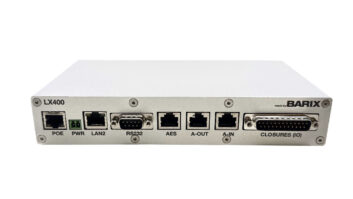(click thumbnail)The Cellphone IFB from Active Media was designed for television reporters doing live remotes. The unit acts as a headset with a mute switch. In practice, the TV reporter would call into the studio’s IFB (interruptible foldback mix of program and cues) line, insert an earpiece into the unit and can hear cues while reporting on the air live. A lavalier microphone plugs into the unit for talkback, if needed. The reporter flips a switch to talk. The Cellphone IFB unit plugs into the headset jack or proprietary input adapter of a cell phone for the feed back to the studio.
The unit comes with a microphone cord using TA5F connectors (which look like tiny XLR plugs) to plug into the body of the Cellphone IFB unit.
The Cellphone IFB weighs well less than 8 ounces with battery. It is powered by a 9 volt battery (alkaline or lithium cells will work). I used one 9 volt battery for all of the on-air cellphone work I did at Daytona Speedweeks 2008.
Broadcast use
Many Radio World readers (including me) have schlepped their share of remote mixers, microphones, cords and other ancillary gear to impromptu remotes. That schlepping gets especially complicated and heavy if the talent enjoys working the crowd while broadcasting (additional cabling required for instance).
The radio news application is obvious; it morphs into the radio remote application. The user can substitute a handheld XLR-connected microphone. I used both a Shure SM63 and Audio-Technica AT897 to substitute for the lavalier microphone when I tested the unit.
Product CapsuleActive Media Cellphone IFB
Thumbs Up

- Compact package, clips to belt, straps, weighs next to nothing
- Plenty of gain to cut through background sound
- TA5F connector for microphone prevents accidental disconnect issue
Thumbs Down
- Volume knob can be inadvertently turned, discharging battery if not clipped to belt
Price
$450
Contact
Active Media | (250) 213-1840 | www.cellphoneifb.comThe set up is simple: Connect the microphone to the unit’s microphone jack. Turn on the Cellphone IFB and plug the output cable (2.5 mm TRS headset plug) into the cellphone or its headset adapter. Plug in an In-Ear Clarifier or Telex Earset ear piece (used by TV crews and others like police, Secret Service, etc.). Flick the switch on the Cellphone IFB to the talk position, then dial the call to the studio. Once the connection is made, the user can hear the studio end, and can mute the send end (if in a noisy environment, like a NASCAR Sprint Cup Series Victory Lane) before the user needs to take the air or is recorded.
In use I found that the Cellphone IFB gave plenty of gain to a Telex Earset, and the AT897/SM63 microphones on the send end. The audio fidelity would not please an audio purist, but for the kind of ad hoc work done over cell phones, it makes a noticeable difference, and uses every bit of the 300 Hz – 3 kHz audio band.
If the user’s cellphone does not need a headset adapter, both units can be clipped to the belt and the user can roam with one hand free. My Nokia 6103 cellphone has a proprietary headset adapter, so I had to hold the phone in one hand, and the microphone in the other. This posed no problem. So this means that the talent who likes to work the crowd can broadcast among the crowd, and not be tethered to a mixer. The Cellphone IFB lets the user do an interview without having to pass the phone back and forth between the interviewer and interviewee. Everything necessary for an impromptu broadcast can be fit into a fanny pack.
Some glitches: One was a dodgy microphone cable that caused the signal to cut in and out. But a quick call to Active Media, and another was on its way. (Ed. note: Active Media now ships the Cellphone IFB with a stronger cable.) The other involved the plastic collar on the knob that adjusts receive levels. During use and transport, the plastic collar cracked off the metal base (it might have been overtightened originally); that had no effect on the operation on the unit. The knob also turns on the unit and may, if put in a fanny pack, turn on and discharge the battery.
A caveat: The unit is designed for the Telex/In-Ear Clarifier 1/8-inch plugs and receivers. Those professional headsets cost somewhat more but last longer than the inexpensive Walkman/iPod style headphones you see almost everywhere.
I have Telex receivers, connector cords and eartubes that I’ve used off and on for some 20 years, and they still work and take up hardly any space in my remote kit. All one needs to do is replace silicone eartips on the eartubes or earmolds from time to time. It’s a question of whether one likes to buy something inexpensive and replace it more frequently, or buy something once, and not have to replace it as often.












